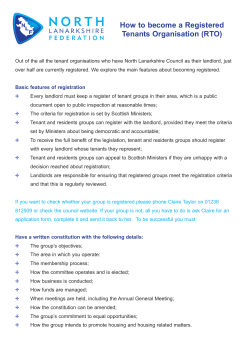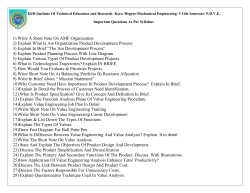
SYLLABUS PS1355 National, State and Local Governments Onsite Course
ITT Technical Institute PS1355 National, State and Local Governments Onsite Course SYLLABUS Credit hours: 4.5 Contact/Instructional hours: 45 (45 Theory Hours) Prerequisite(s) and/or Corequisite(s): Prerequisites: EN1320 Composition I or equivalent Course Description: This course examines both the United States and Nevada Constitutions and the relationship between the state and federal governments. National, State and Local Governments Syllabus Where Does This Course Belong? Program Scope and Core Content Areas General Education courses include courses in the humanities, composition, mathematics, the sciences, and the social sciences. This course belongs to the General Education Social Sciences curriculum. Program Goals and Objectives General Education courses are designed to provide ITT Tech students with a well-rounded education in the context of their technical programs. Each course emphasizes one or more of ITT Tech’s General Education Student Learning Outcomes. 1. The student will be able to demonstrate personal responsibilities 2. The student will be able to analyze information. 3. The student will be able to solve complex problems. 4. The student will be able to communicate effectively in oral, written and visual forms. 5. The student will be able to contribute as a member of a team. 6. The student will be able to pursue lifelong learning opportunities. Career Impact General Education courses provide breadth to a core technical program. Courses in General Education are intended to broaden a student’s educational experience, and therefore, broaden his/her perspective. 1 Date: 1/26/2013 National, State and Local Governments Syllabus Course Summary Major Instructional Areas 1. Foundation of the U.S. Constitution 2. Structure and functions of the federal government 3. Nevada State Government 4. Relationship between state and local governments and the federal government 5. Role of courts and judiciary in shaping government policies Detailed Topical Outline 1. Government by and for the People 1.1. Government, politics, policy 1.2. Current events 1.3. U.S. population, Constitutional census 1.4. U.S. political values 1.5. Policymaking 2. The U.S. Constitution and Nevada State Constitution 2.1. Foundations of American political culture 2.2. Constitutional principles 2.3. Articles of Confederation 2.4. Bill of Rights 2.5. Constitutional change 2.6. Nevada Constitution 2.7. State Building 3. U.S. Federalism and Nevada State Constitution (1864) 3.1. Federalism and the Constitution 3.2. Powers and Roles of national and state governments. 3.3. Conflicts Over Federalism 3.4. Nevada Constitution (1864) 3.5. Statehood 4. Civil Liberties and Civil Rights 4.1. First Amendment 2 Date: 1/26/2013 National, State and Local Governments Syllabus 4.2. Due process 4.3. Civil liberties 4.4. Civil Rights 4.5. Voting Rights 4.6. Civil Liberty Issues of Nevada 5. The U.S. Congress and Nevada State Legislature 5.1. Constitutional Structure: Bicameral 5.2. Membership 5.3. Organization: Committees and Subcommittees 5.4. Legislative Process 5.5. Nevada Legislature 5.6. Redistricting and Apportionment 6. The Presidency, the Governor, and the Mayor 6.1. Constitutional Presidency 6.2. Presidential Powers 6.3. Modern Presidency 6.4. Organization of the Presidency 6.5. Theories of Presidential Leadership 6.6. Presidential Popularity 6.7. Powers of the Governor 6.8. Mayoral Influence 7. The U.S. Supreme Court and Nevada State Courts 7.1. The Supreme Court: Structure and Organization 7.2. The Lower Federal Courts 7.3. Nevada State Courts 7.4. Judicial Policymaking 7.5. Judicial Discipline 3 Date: 1/26/2013 National, State and Local Governments Syllabus 8. Political Participation 8.1. Patterns of Political Participation 8.2. Voter Turnout 8.3. Voter Apathy 8.4. Interest Groups 8.5. Lobbying 8.6. Voting Patterns 8.7. Elections 8.8. Political Campaigns 9. Opinion and the News Media 9.1. Political Opinion 9.2. Use and Acquisition 9.3. Political Socialization 9.4. Political Philosophy 9.5. Liberalism 9.6. Conservatism 9.7. Public Opinion and Public Policy 10. Economic and Foreign Policy Making 10.1. Revenues 10.2. Nevada State Income Tax 10.3. Expenditures 10.4. Government Deficits & Debt 10.5. Fiscal Policy 10.6. Federal Reserve Board 10.7. Isolationism v. Internationalism 4 Date: 1/26/2013 National, State and Local Governments Syllabus 10.8. 9/11 and the War on Terror Course Objectives 1. Analyze the nature and purpose of government. 2. Analyze the organization, function and relationships of U.S. federal and state governments. 3. Explain the origins of democratic ideas and philosophies. 4. Analyze the political beliefs of the U.S.'s founders and the influence of these ideas on the development of the United States. 5. Summarize the articles, sections, and amendments of the U.S. Constitution. 6. Assess the impact of the component parts of the U.S. Constitution on American political processes. 7. Compare and contrast the U.S. and state constitutions. 8. Analyze various case studies using U.S. Constitutional principles. 9. Debate civil liberties guaranteed by the Bill of Rights of the U.S. Constitution and by the 14th Amendment. 10. Analyze the role and impact of political parties, media, and interest groups on policy and the U.S. political process. 11. Evaluate the federal and state nomination and election process to determine if it is an effective and efficient way to choose government leaders. 12. Evaluate the impact of budgeting, taxation and basic problems of finance on national, state and local governments. 13. Analyze the impact of courts and the judiciary on public policy. 14. Prepare oral and visual presentations on selected topics using information from the ITT Tech Virtual Library. Learning Materials and References Required Resources New to this Textbook Package Course Tannahill, N. (2012). THINK: American government. (4th custom ed.). Boston: Longman. 5 Carried over Required for from Previous Subsequent Course(s) Course(s) n Date: 1/26/2013 National, State and Local Governments Syllabus Harward, B. (2013). The 2012 election. Boston, MA: Pearson Education. Bowers, M. (2006). The Sagebrush State: Nevada’s History, Government, and Politics. (3rd Ed.) n n New to this Other Items Course Carried over Required for from Previous Subsequent Course(s) Course(s) Optional: Art supplies: poster board, scissors, Post-Its, glue sticks. Your instructor will alert you if these are n necessary. Note: all required primary documents are provided by the instructor. Recommended Resources Books, Professional Journals Political Science Quarterly http://www.psqonline.org/ (accessed 1/14/2012) Published by the Academy of Political Science since 1886, this scholarly journal covers government, politics, and policy. Some content on the web site is free. American Political Science Review http://www.apsanet.org/content_3222.cfm?navID=255 (accessed 1/14/2012) The American Political Science Review (APSR) presents peer-reviewed research articles by political scientists of all subfields. PS: Political Science & Politics https://www.apsanet.org/content_2819.cfm?navID=257 (accessed 1/14/2012) PS: Political Science & Politics is a peer-reviewed journal focusing on contemporary politics. Professional Associations American Political Science Association http://www.apsanet.org/ (accessed 1/14/2012) The APSA is a leading professional organization for the study of political science. National Social Sciences Association http://nssa.us/ (accessed 1/14/2012) The National Social Science Association (NSSA) is a national interdisciplinary association devoted to interaction among social scientists. 6 Date: 1/26/2013 National, State and Local Governments Syllabus Other References Pew Research Center http://pewresearch.org/ (accessed 1/14/2012) The Pew Research Center is a nonpartisan "fact tank" that provides information on the issues, attitudes and trends shaping America and the world. It does so by conducting public opinion polling and social science research; by analyzing news coverage; and by holding forums and briefings. It does not take positions on policy issues. o The Economist Periodicals> EbscoHost Academic Search Elite> Economist Edited in London since 1843, The Economist is a weekly international news and business publication, offering reporting, commentary, and analysis on world current affairs, business, finance, science and technology, culture, society, media, and the arts. Books> Open CRS (Congressional Research Reports) The Center for American Politics and Public Policy http://www.cappp.org/ (accessed 1/14/2012) CAPPP focuses on research that relates to public policy processes, including issues of agenda setting, decision-making, implementation, regulation, the development of quantitative measures of policy change, and the role of ideas and dialogue in policy change. U.S. Census Bureau http://www.census.gov/ (accessed 1/14/2012) This site provides myriad statistics about the U.S. population. The Think Spot www.thethinkspot.com (accessed 1/14/2012) This site provides supplementary study material for the Think: American Government textbook. ITT Tech Virtual Library (accessed via Student Portal) Reference > Opposing Viewpoints in Context School of Study> General Education> Databases o EbscoHost Academic Search Elite o EbscoHost Business Source Premier – Publications: American Journal of Political Science School of Study> General Education> Recommended Links 7 Date: 1/26/2013 National, State and Local Governments Syllabus o Grammar, Writing, and Style: APA Formatting and Style Guide o Grammar, Writing, and Style: APA Style NOTE: All links are subject to change without prior notice. Information Search Use the following keywords to search for additional online resources that may be used for supporting your work on the course assignments: American political parties Separation of powers Nevada Legislation Nevada Constitution Nevada Court System Federalism Voter participation in the United States Civil liberties The U.S. Constitution Electoral college Public campaign funding Supreme Court States' rights American government NOTE: All links are subject to change without prior notice. 8 Date: 1/26/2013 National, State and Local Governments Syllabus Course Plan Suggested Learning Approach In this course, you will be studying individually and within a group of your peers. As you work on the course deliverables, you are encouraged to share ideas with your peers and instructor, work collaboratively on projects and team assignments, raise critical questions, and provide constructive feedback. Use the following advice to receive maximum learning benefits from your participation in this course: DO DON’T Do take a proactive learning approach. Don’t assume there is only one correct Do share your thoughts on critical issues answer to a question. and potential problem solutions. Don’t be afraid to share your perspective on the issues analyzed in the course. Do plan your course work in advance. Do explore a variety of learning resources in Don’t be negative about the points of view that addition to the textbook. are different from yours. Do offer relevant examples from your Don’t underestimate the impact of experience. collaboration on your learning. Do make an effort to understand different Don’t limit your course experience to reading points of view. the textbook. Do connect concepts explored in this Don’t postpone your work on the course course to real-life professional situations deliverables – work on small assignment and your own experiences. components every day. 9 Date: 1/26/2013 National, State and Local Governments Syllabus Course Outline Unit 1: GOVERNMENT FOR THE PEOPLE, BY THE PEOPLE Out-of-class Upon completion of this unit, the students are expected to: work: Identify the purpose of government. Differentiate between the terms government, politics, and policy. Design a plan to construct a visual representation of the U.S. Constitution. Identify and appraise the impact of changes in the U.S. population on the U.S. 6 hrs. political arena. Categorize the stages of the policy making process in U.S. politics. Assess the impact of U.S. political values on policy. Evaluate current events and draw connections between current events, the U.S. Constitution, and themes of U.S. Government. GRADED ACTIVITIES / DELIVERABLES Grade READING ASSIGNMENT Grading Activity/Deliverable Title Category Allocation (% of all graded work) Tannahill, Introduction, pp. Exercise Unit 1 Exercise 1: Policymakers Assignment Unit 1 Assignment 1: Unit 1 Homework 1.5% 3-9; Chapter 1, pp. 11-25 Primary Source: U.S. Constitution, Article I, 3% Section 2 (Handout) 10 Date: 1/26/2013 National, State and Local Governments Syllabus Unit 2: THE U.S. CONSTITUTION AND NEVADA STATE CONSTITUTION Out-of-class Upon completion of this unit, students are expected to: work: Analyze the historical events and philosophical ideas that influenced the 9 hrs. development of the U.S. and Nevada Constitutions. Identify and summarize the core constitutional principles of representative democracy, separation of powers, bicameralism, and federalism. Identify the various ways in which the U.S. Constitution limits the power of American federal, state and local government. Identify and summarize the various mechanisms by which the U.S. and Nevada Constitutions can be modified. Evaluate current events and draw connections between current events, the U.S. Constitution, and themes of U.S. Government. GRADED ACTIVITIES / DELIVERABLES Grade READING ASSIGNMENT Grading Category Allocation Activity/Deliverable Title (% of all graded work) Exercise Tannahill, Chapter 2, pp. 26-45 Bowers, Chapter 2, pp. 17-20; Appendix, Different Systems of pp. 139-249, NV Constitution Government Primary Source: The Federalist #51 by Unit 2 Exercise 2: State Making Unit 2 Exercise 1: Compare 1% 1% James Madison (Hand out) http://leg.state.nv.us/Const/NVConst.thml Assignment Unit 2 Assignment 1: Unit 2 2.5% Homework 11 Date: 1/26/2013 National, State and Local Governments Syllabus Unit 3: FEDERALISM AND NEVADA STATE CONSTITUTION (1864) Out-of-class Upon completion of this unit, students are expected to: work: Identify the constitutional functions and powers of the three branches of 10 hrs. government and apply them to the States’ Rights debate. Identify how and why state and local governments impact public policymaking. Analyze the States’ rights debate through the examination of Supreme Court rulings. Design a visual representation of the division of powers among federal, state and local governments. Evaluate current events and draw connections between current events, the U.S. Constitution, and themes of U.S. Government. Explain how Federalism affects Nevada Identify the struggle of Nevada becoming a State Explain the price Nevada paid for Statehood GRADED ACTIVITIES / DELIVERABLES Grade READING ASSIGNMENT Allocation Grading Activity/Deliverable Title Category (% of all graded work) Tannahill, Chapter 3 Bowers, Chapter 2, pp. Exercise Unit 3 Exercise 1: Policy Role-play 20-27 Quiz Unit 3 Quiz 1 (covers Units 1-2) 3% Primary Source: Project Unit 3 Project Part 1: Project Proposal 3% Gonzales v. Raich 545 Assignment Unit 3 Assignment 1: Unit 3 Homework 2% Unit 3 Assignment 2: Yucca Mountain 1% U.S. 1 (2005) (Hand out) “Why Does the State 1.5% Oppose Yucca Mountain?” http://www.state.nv.us/n ucwaste/yucca/state01.h tm ITT Tech Virtual Library> Reference> Audio and Video Learning> Annenberg learner > 12 Date: 1/26/2013 National, State and Local Governments Syllabus View Programs tab> Democracy in America > Federalism: U.S. v. the States > Select the VOD [video on demand] box to the right. You may also access the video directly: http://www.learner.org/vod/vod_ window.html?pid=1913 13 Date: 1/26/2013 National, State and Local Governments Syllabus Unit 4: CIVIL LIBERTIES & CIVIL RIGHTS Out-of-class Upon completion of this unit, students are expected to: work: Analyze the constitutional foundation for civil liberties in America. Identify and summarize the various freedoms protected by the U.S. Constitution, 11 hrs. with an emphasis on the Bill of Rights. Evaluate the constitutional basis for privacy rights in the United States and assess some of the controversies to which this particular right has been applied. Describe the nature of due process of law and explain the various constitutional rights of those accused of crimes. Describe and analyze the relationship between constitutionally protected civil liberties and the “War on Terror.” Determine the nature by which the Fourteenth Amendment and the Equal Protection Clause influence civil rights. Identify and evaluate the various ways in which the U.S. government has protected citizens from discrimination. Describe the history of voting rights in America, including the Voting Rights Act of 1965 and the current trend towards disenfranchisement. Evaluate current events and draw connections between current events, the U.S. Constitution, and themes of U.S. Government. GRADED ACTIVITIES / DELIVERABLES Grade READING ASSIGNMENT Grading Activity/Deliverable Title Category Allocation (% of all graded work) Tannahill, Chapters 4 Exercise and 5 Bowers, Chapter 3, pp. Assignment Primary Source: C.J. Unit 4 Assignment 1: Unit 4 Homework 1.5% Unit 4 Assignment 2: White Men Can 1.5% Vote Miranda v. Arizona 384 U.S. 436 (1966) (Hand 1.5% Accused in the United States 28-30 Unit 4 Exercise 1: The Rights of the Project Unit 4 Project Part 2: Survey Research 5% out) Primary Source:. “All Laws But One” http://www.secinecview s.com/parks/habeascor 14 Date: 1/26/2013 National, State and Local Governments Syllabus pus.html Operation G-Sting http://www.8newsnow.c om/category/60126/hist ory-of-g-sting Unit 5: U.S. CONGRESS AND NEVADA STATE LEGISLATURE Out-of-class Upon completion of this unit, the students are expected to: work: Identify the historical reasons and constitutional structure of bicameralism in the 5 hrs. U.S. Congress. Compare and contrast the membership, organization and the internal distribution and use of power of the U.S. Senate and the U.S. House of Representatives. Describe the steps of the legislative process of the U.S. Congress and debate their efficiency Create a graphic that reflects the Constitutional powers and relationships of the U.S. Congress and Nevada Legislature. Evaluate current events and draw connections between current events, the U.S. Constitution, and themes of U.S. Government. GRADED ACTIVITIES / DELIVERABLES Grade READING ASSIGNMENT Grading Activity/Deliverable Title Category Allocation (% of all graded work) Tannahill, Chapter 12 Bowers, Chapter 4, pp. 53- Exercise. Unit 5 Exercise 1: Compare and 1.5% Contrast Houses and Senates 55; Chapter 6, pp. 66-77 Quiz Unit 5 Quiz 2 (Covers Units 3-4) 3% Federalist 57 (Hand out) Assignment Unit 5 Assignment 1: Unit 5 2% Homework Unit 5 Assignment 2: Initiative 15 1% Date: 1/26/2013 National, State and Local Governments Syllabus Unit 6: THE PRESIDENCY, THE GOVERNOR, AND THE MAYOR Out-of-class Upon completion of this unit, students are expected to: work: Describe the nature of the presidency as defined in the Constitution. Identify and analyze the powers of the presidency and State executives. Describe the relationship between the presidential bureaucracy and the overall 12 hrs. organization of the presidency. Analyze the various theories of presidential leadership and the various factors associated with presidential popularity. Evaluate current events and draw connections between current events, the U.S. Constitution, and themes of U.S. Government. GRADED ACTIVITIES / DELIVERABLES Grade READING ASSIGNMENT Grading Category Activity/Deliverable Title Allocation (% of all graded work) Tannahill, Chapter 11, pp. 204-215; Exercise Bowers, Chapter 7, pp. 78-90 Primary Source: President Obama’s Inaugural Address http://www.whitehouse.gov/blog/inaug Assignment Unit 6 Assignment 1: Unit 6 3% Homework Project Unit 6 Project Part 3: 5% Journaling ural-address/ 1.5% Powers of the Presidency? Chapter 13 Unit 6 Exercise 1: What Are the Governor’s Staff http://gov.nv.gov/staff World Wide Goodman www.bbc.co.uk/news/world-uscanada-13700493 16 Date: 1/26/2013 National, State and Local Governments Syllabus Unit 7: THE FEDERAL COURTS AND NEVADA STATE COURTS Out-of- Upon completion of this unit, the students are expected to: class Identify the origins and organization of lower federal courts and suggest an alternative work: structure. 10 hrs. Develop and organize a map of the Constitutional powers and relationships of U.S. Supreme Court. Analyze the operational function of the U.S. Supreme Court and Nevada State Courts, and debate lifetime term of U.S. Supreme Court justices. Assess the impact of the Supreme Court on policy making. Analyze the ability of Judicial Review. Evaluate current events and draw connections between current events, the U.S. Constitution, and themes of U.S. Government. GRADED ACTIVITIES / DELIVERABLES Grade READING ASSIGNMENT Grading Category Allocation Activity/Deliverable Title (% of all graded work) Tannahill, Chapter 15 Bowers, Chapter 8, pp. 91-104 Lifetime Term for Primary Source:Fran Deane Origins Supreme Court http://www.lasvegassun.com/news/2003/sep/19/dea Justices Exercise nes-assistant-leaving-county-recorders-office/ Assignment Fran Deane Trial 1.5% Unit 7 Assignment 1: 3% Unit 7 Homework http;//www.lasvegassun.com/news/2010/jan/14/excounty-official-frances-deane-gets-five-years-p/ Unit 7 Exercise 1: Quiz Unit 7 Quiz 3 3% (covers Units 5-6) Current Supreme Court Docket 17 Date: 1/26/2013 National, State and Local Governments Syllabus Unit 8: POLITICAL PARTICIPATION Out-of-class Upon completion of this unit, the students are expected to: work: Describe the various ways in which citizens can participate in the political process. Compare and contrast voter turnout in the United States with turnout in other global 9 hrs. democracies. Describe the various types and goals of interest groups in American politics. Analyze the strategies, tactics, and relative strength of interest groups and political parties. Use statistics and exit polls to differentiate between the typical Republican and Democratic voter. Describe various factors that affect voter choices. Describe how U.S. elections are conducted Describe how political campaigns are organized. Evaluate current events and draw connections between current events, the U.S. Constitution, and themes of U.S. Government. GRADED ACTIVITIES / DELIVERABLES Grade READING ASSIGNMENT Grading Activity/Deliverable Title Category Allocation (% of all graded work) Tannahill, Chapter 7; Chapter Unit 8 Exercise 1a: Interest Groups and 9; Chapter 10, pp. 180-182; the Legislative Process Chapter 11, pp. 190-201; Or 215-217 Unit 8 Exercise 1b: Voter Apathy – Bowers, Chapter 4, pp. 45-48; Does Low Voter Turnout Matter? Chapter 5, pp. 59-65 Exercise Primary Source: Voting and Registration in the Election of 1.5% Assignment Unit 8 Assignment 1: Unit 8 Homework 3% Project Unit 8 Project Part 4: Rough Draft 5% November 2008 (Hand out) 18 Date: 1/26/2013 National, State and Local Governments Syllabus Unit 9: PUBLIC OPINION AND THE MEDIA Out-of-class Upon completion of this unit, the students are expected to: work: Differentiate the political philosophies of liberals and conservatives and challenge 10 hrs. assumptions. Evaluate and debate the influence of the impact of public opinion and political socialization on the American political process. Survey various news media for bias; analyze and present findings. Evaluate the role of media in the U.S. political process and its relation to public policymaking. Analyze the relationship between government and media by examining government regulation of media. Evaluate current events and draw connections between current events, the U.S. Constitution, and themes of U.S. Government. GRADED ACTIVITIES / DELIVERABLES Grade READING ASSIGNMENT Grading Category Activity/Deliverable Title Allocation (% of all graded work) Tannahill, Chapter 6, pp. Exercise Unit 9 Exercise 1 Role Play: 104-127; Chapter 8, pp. Managing the Media, Managing the 142-155 Candidate 1.5% Selected news media Assignment Unit 9 Assignment 1: Unit 9 3% Homework Quiz Unit 9 Quiz 4 (covers Units 7-8) 19 3% Date: 1/26/2013 National, State and Local Governments Syllabus Unit 10: ECONOMIC & FOREIGN POLICY MAKING Out-of- Upon completion of this unit, the students are expected to: class work: Describe the primary goals of economic policy. Identify the various means by which the government raises revenue. Identify and categorize the subjects and sectors in which the government spends its 9 hrs. revenues. Identify and explain the issues with Nevada State’s Income Tax System Describe the ways in which Congress, the president, and the Federal Reserve Board engage in economic and fiscal policymaking. Identify and explain the role of the various elements of the international foreign policy community, as well as the nature of the relationship between this community and the United States. Differentiate between isolationism and internationalism in the context of foreign policy. Compare and contrast the unilateralist and internationalist approaches to foreign policy Evaluate current events and draw connections between current events, the U.S. Constitution, and themes of U.S. Government. GRADED ACTIVITIES / DELIVERABLES Grade Allocation READING ASSIGNMENT Grading Category Activity/Deliverable Title (% of all graded work) Tannahill, Chapters 16 and Exercise Unit 10 Exercise 1: Deficits and 17 Bowers, Chapter 10, pp. Debts Assignment Unit 10 Assignment 1: Unit 10 112-121 1.5% 3% Homework Eisenhower's MilitaryIndustrial Complex speech (Hand out) 20 Date: 1/26/2013 National, State and Local Governments Syllabus Unit 11: COURSE REVIEW, FINAL EXAMINATION, AND PRESENTATION Out-of-class Upon completion of this unit, the students are expected to: work: Evaluate knowledge of all course objectives. Present audio and visual summary of a legislative argument. 10 hrs. GRADED ACTIVITIES / DELIVERABLES Grade READING ASSIGNMENT Grading Activity/Deliverable Title Category Allocation (% of all graded work) Presentation Exam Final Exam 15% Project Unit 11 Project Part 5: Final 10% Presentation (PORTFOLIO) Note: Your instructor may add a few learning activities that will change the grade allocation for each assignment in a category. The overall category percentages will not change. Evaluation and Grading Evaluation Criteria The graded assignments will be evaluated using the following weighted categories: Category Assignment Project Exercise Weight 29.5% 28% 15.5% Quiz 12% Exam 15% TOTAL 100% 21 Date: 1/26/2013 National, State and Local Governments Syllabus Grade Conversion The final grades will be calculated from the percentages earned in the course, as follows: Grade Percentage Credit A 90–100% 4.0 B+ 85–89% 3.5 B 80–84% 3.0 C+ 75–79% 2.5 C 70–74% 2.0 D+ 65–69% 1.5 D 60–64% 1.0 F <60% 0.0 Academic Integrity All students must comply with the policies that regulate all forms of academic dishonesty, or academic misconduct, including plagiarism, self-plagiarism, fabrication, deception, cheating, and sabotage. For more information on the academic honesty policies, refer to the Student Handbook and the Course Catalog. 22 Date: 1/26/2013
© Copyright 2025












